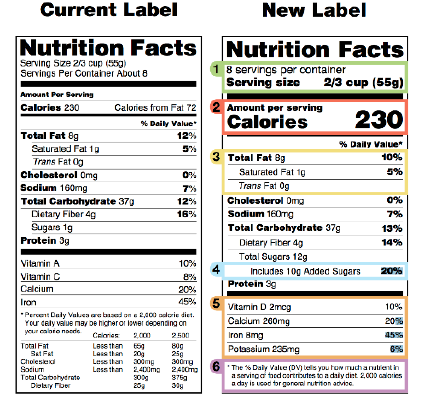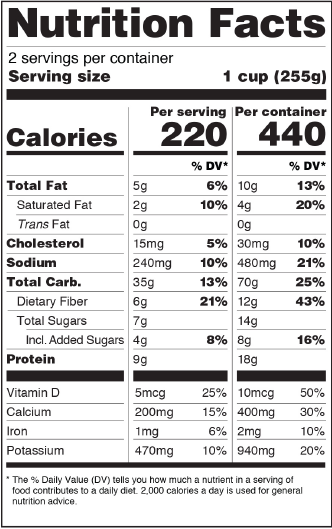BLOG: Food Labels
With all of the foods crowding the shelves of our grocery stores, how do we decide what to buy for our pantry? Most of us have heard the advice to stay on the outside aisles at the grocery store (which usually contain fresh fruits, vegetables and dairy) and away from the center aisles which often contain highly processed foods. The nutrition label on packaged foods is another tool to help in our choices. A new Nutrition Facts Label is going to be required on all packaged foods in the U.S. The new label was slated to go into effect on July 26, 2018 but is now on hold pending challenges from some food manufacturers.

The new nutrition label contains 15 mandatory components. Manufacturers may add additional items at their discretion. The mandatory items are in bold type and will be found in the order below.
- total calories
- total fat
- saturated fat
- trans fat
- polyunsaturated fat
- monounsaturated fat
- cholesterol
- sodium
- potassium
- total carbohydrate
- dietary fiber
- soluble fiber
- insoluble fiber
- total sugars
- added sugars
- sugar alcohol (e.g. the sugar substitutes xylitol, mannitol and sorbitol)
- other carbohydrates*
- protein
- vitamin D and actual amount
- calcium and actual amount
- iron and actual amount
- potassium and actual amount
- other essential vitamins and minerals

At the top of the label, changes include a bolder font for CALORIES, and standardization of the serving sizes. Calories measure the energy in a food serving. The number of calories consumed correlates directly with weight, and eating too many calories, even of “healthy” foods, will lead to obesity. To give a sense of calorie content, 100 calories is a moderate number of calories per serving and 400 a high number of calories per serving. Many snack bars and protein bars contain over 240 calories. The standardization of serving sizes will allow similar products to be more easily compared. Thus a single serving size of Lays potato ships should be the same size as a single serving of Pringles.
On the right hand side of the label is the % Daily (reference) Value in a serving. The daily reference value of a nutrient is the grams of nutrient intake suggested by the FDA, in a 2000 calorie a day diet. If a serving contains a DV of 5% or less, it is a low source of a nutrient. If a serving contains a DV of 20% or more, it is a high source of a nutrient. You want to choose foods that have high % DV of fiber and protein and low % DV of carbohydrates, added sugars and unhealthy fats.
Total Fat includes saturated fats, trans fats, and cholesterol. Total fat should make up 20-35% of calories. Labels began showing trans fats in January 2006. These should be less than 1% of total daily calories.
Sodium is limited to 2300 mg /day.
Total Carbohydrates include dietary fiber, natural sugars (those naturally found in the food), and added sugars. Total daily reference value for carbohydrate is 130 grams /day of which
25-38 grams should be in the form of fiber (for men and women respectively).
Sugars: There is no daily reference value for sugars (more on this in a later blog). Most nutritionists agree added sugars should be 10% or less of your daily total calories.
Protein: Since protein is a macronutrient there is no assigned % Daily Value on the label.
Micronutrients make up the rest of the label; Vitamin D, Calcium, iron and potassium are required to be on the label. Optional micronutrients include Vitamin A and Vitamin C. Manufacturers may add an ingredient list, as well as health and functional claims.
To make us more aware of the number of calories in a container, some food package nutrition labels will have two columns. The first indicates calories per serving size, the second indicates calories per package. Perhaps we will pause for a moment before consuming the whole package and ask ourselves. Are we truly hungry, or just mindlessly munching?
The label change increases the transparency of food choice. It is a step toward rational eating, instead of mindless ingesting. Learn to look at these new labels, they can help you in thoughtfully planning your meals and food purchases.
David Wendt, MD, FACC



